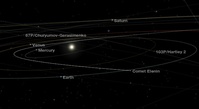COBS News archive
New Comet: C/2012 B3 (LA SAGRA)
February 04, 2012
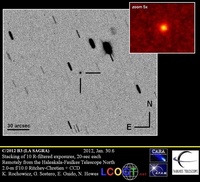
Cbet nr. 3012, issued on 2012, February 04, announces the discovery of a new comet (discovery magnitude 18.3) on CCD images taken with the 0.45-m f/2.8 reflector at La Sagra, Spain on January 29.1, 2012. The apparently asteroidal object was later noted by Jaime Nomen on La Sagra images taken on Jan. 30.2 to be a possible comet with slight diffuseness. The new comet has been designated C/2012 B3 (LA SAGRA).
New Comet: P/2011 VJ5 (LEMMON)
February 03, 2012

Catching a Comet Death On Camera
January 24, 2012
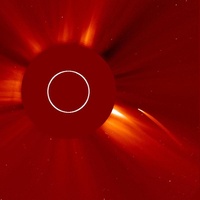
New comet C/2012 A2 (LINEAR)
January 19, 2012

C/2012 A2 (LINEAR) was discovered by the LINEAR survey on 2012, Jan. 15.41 with a 1.0-m f/2.15 reflector + CCD located near Socorro, New Mexico.
It was subsequently placed on the NEO Confirmation Page, where other observatories (including me at 204, P. Birtwhistle from Great Shefford-J95, H. Sato remotely from GRAS-H06 and R. Holmes et al. from H21-ARI) confirmed it as a comet.
Comet C/2011 UF305 (LINEAR)
January 02, 2012
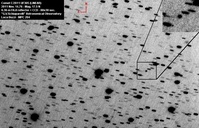
New comet C/2011 Y3 (Boattini)
December 30, 2011

C/2011 Y3 (Boattini) was discovered by Andrea Boattini on 2011, Dec. 25.24 with the 1.5-m f/2 reflector + CCD from Mount Lemmon Sky Survey (part of the Catalina Sky Survey). He described the comet as being very diffuse with central condensation: four 30-s exposures show a 6 arcsec coma and a wide fan-shaped tail about 30 arcsec long in p.a. 240-245 deg.
New comet P/2011 Y2 (Boattini)
December 29, 2011

Comet Lovejoy from Orbit
December 25, 2011

Christmas Comet Lovejoy Captured at Paranal Observatory in Chile
December 24, 2011

Comet C/2011 W3 (Lovejoy) approaches the Sun - UPDATE 2011-12-21
December 21, 2011
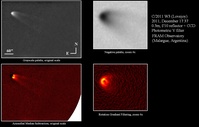
Comet C/2011 W3 (Lovejoy) approaches the Sun - UPDATE 2011-12-17
December 17, 2011

Comet C/2011 W3 (Lovejoy) approaches the Sun - UPDATE
December 16, 2011

Comet C/2011 W3 (Lovejoy) approaches the Sun
December 15, 2011
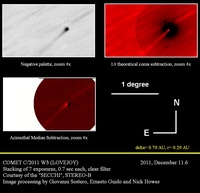
NASAs Deep Impact Spacecraft Eyes the Future
December 08, 2011
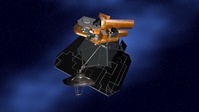
C/2011 W3 (LOVEJOY) - Kreutz Sungrazing Comet
December 07, 2011
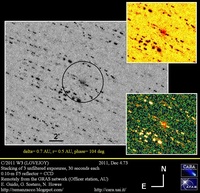
Cbet nr.2930, issued on 2011, December 02, announces the discovery of a new comet (discovery magnitude 13) by Terry Lovejoy on three CCD images obtained each on Nov. 27.7 and 29.7 UT with a Celestron 8 0.20-m f/2.1 Schmidt-Cassegrain reflector (+ QHY9 camera). The new comet has been designated C/2011 W3 (LOVEJOY).
New Comet: P/2011 W2 (RINNER)
December 01, 2011
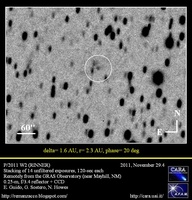
Cbet nr.2922, issued on 2011, November 29, announces the discovery of a new comet (discovery magnitude 17.9) by Claudine Rinner on CCD images obtained on November 28, 2011 taken with a 0.5-m f/3 reflector located at the Oukaimeden Observatory near Marrakech, Morocco. The new comet has been designated P/2011 W2 (RINNER).
COMET P/2010 UH55 (SPACEWATCH)
November 30, 2011

Recovery of comet 171P/Spahr
October 29, 2011

On October 19.5, 2011 we started an observing session to recover the periodic comet 171P/Spahr. T. B. Spahr (then at University of Arizona, Arizona, USA - now Director, Minor Planet Center) discovered this comet with the 0.41-m f/3 Schmidt telescope in the course of the Catalina Sky Survey on 1998 November 16.39.
New Comet: C/2011 U2 (BRESSI)
October 28, 2011

NASA Says Comet Elenin Gone and Should Be Forgotten
October 27, 2011
